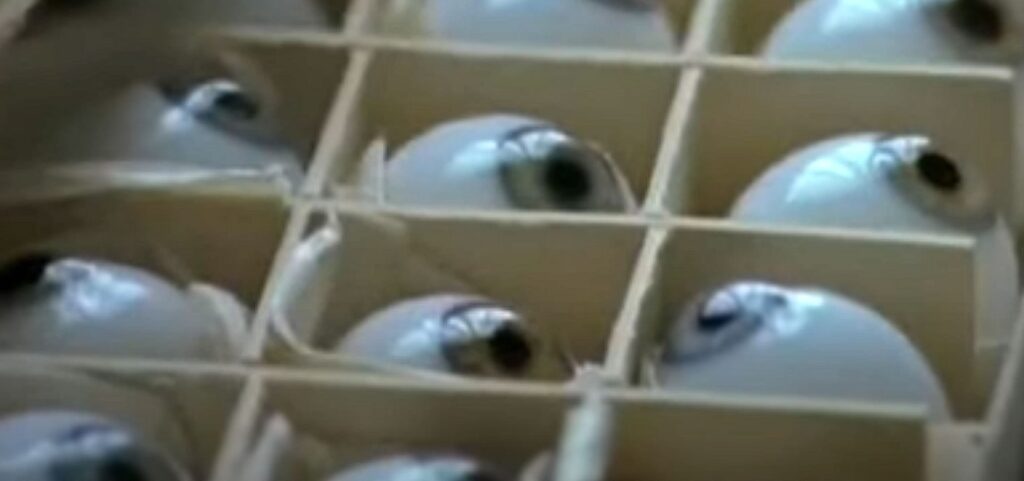No. These days the use of glass in artificial eyes has largely been superseded by acrylic plastic – the “modern” material of prosthetic eye making.
Artificial eyes have been recorded in history for many thousands of years being in existence from the Egyptian Fourth Dynasty (2613-2494 BC) till the Sixth (664-525 BC) as part of the mummification process and there is evidence of their existence in Ancient Rome, Greece and China too.
However, French surgeon Ambroise Paré (1510-90) could have laid claim to be the father of facial prosthetics. He was the first to describe the use of artificial eyes and constructed them from enamelled gold, silver, porcelain and glass.
Paré made indwelling eyes (the “hypoblephara”) but also external devices retained with wire attachments (the “ekblephara”), as surgical removal of the eyeball was rare until the 19th century. Doubtless Paré’s prostheses were impressive to look at and highly desirable, but must also have been heavy, quite fragile and extremely expensive.
The Glass Eye
The first known Ocularists, constructing artificial eyes from glass during the golden age of Italian glassmaking, came out of Venice in the 16th century.
By the 19th century Europe was acknowledged as a centre of excellence in artistic craftsmanship, and Germany became the centre for glass eye production.
An important figure in the history of artificial eyes from Germany was Ludwig Müller-Uri (1811-88), a maker of doll’s eyes, who developed glass for prosthetic use with local people. In 1868 in collaboration with his nephew Friedrich Müller-Uri a new form of glass called Cryolite was developed. This new type of glass was smoother and more resistant to attack by tear production, thereby increasing the lifespan of an eye. Throughout the Nineteenth Century, teams of German Ocularists would dispense artificial eyes visiting towns and cities in Europe & America. However, glass eye making was still a highly specialised, time consuming and expensive business.
The Last Glass Eye Maker in Britain
Jost Haas works in London; is the last glass eye maker left in Britain; and is close to retirement. He originates from Germany, where glass eye technology was perfected in the 18th century. He still manufactures glass eyes using techniques which have been mostly unchanged for over two hundred years. Nowadays virtually all prosthetic eyes are made from acrylic plastic, rendering Mr. Haas’ undeniable skill almost redundant. There is however, an element of trust and familiarity built up between Ocularist and patient, and that small band of patients who have continued to attend Mr. Haas for their artificial eyes over the years will undoubtedly feel uneasy at the thought of attending another practitioner.
This video stands as a fascinating document of an almost forgotten art which will finally pass into history in the UK when Mr. Hass retires.
Video Transcript
“I came here because my predecessor had been German. I had met him before and then he suddenly passed away, and I was asked if I would take over and I did and that was, as I said, 35 years ago. The people were actually quite kind and the neighbours were very nice too. They greeted us with tea and biscuits!
Well I would like to go on as long as I can because, as I said, I met and made friends with a lot of patients and I don’t want to disappoint them. They still phone me up and still come and see me and until they are not happy anymore – I carry on. I would like them to have the best care possible and I’d like if somebody comes along and carries on the work, but I feel I still have a long time to go.
Because I live in the UK and I’m the only one here and as I’m based in London, I very seldom meet glass eye makers in Germany. Most of them were German in the end you see. That seems to be a very strange affair but that’s how it is. I mean there’s some Austrians and there’s somebody in Switzerland, but it’s mainly in German-speaking countries. The tradition usually came from there and it was a one-man-band only and in Germany they usually taught their children to do glass eyes, but in my case my daughter wanted to do something entirely different and for that reason perhaps it’s not carried on as much here as it would be somewhere else.”
The Acrylic Artificial Eye
These days the use of glass in artificial eyes has largely been superseded by acrylic plastic – the “modern” material of prosthetic eye making. Sources for the history of the acrylic artificial eye vary. In the USA tests were being done on acrylics by the American Optical Company during the Second World War and here in the UK in 1944 a dentist W.D. Barker of Lancaster made an acrylic artificial eye for his son.
Theories surrounding the advantages of this material (resistance to scratches, breakage and attack by lacrimal secretions) were proved to be correct and he was soon engaged in developing his ideas and achieving his objective to produce large numbers as economically as possible by manufacturing stock artificial eyes, pressed in brass moulds and hand painted.
In the clinical environment, patients – at that time largely war injured – could be treated fairly quickly with half-spherical eyes being cut and ground to shape and issued by teams of “technicians” who chose an appropriate eye from a large range of colours and sizes. In respect of his work Mr Barker was awarded the M.B.E. in 1949.














